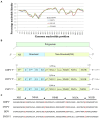Detection of a novel Pestivirus strain in Java ticks (Amblyomma javanense) and the hosts Malayan pangolin (Manis javanica) and Chinese pangolin (Manis pentadactyla)
- PMID: 36118205
- PMCID: PMC9479695
- DOI: 10.3389/fmicb.2022.988730
Detection of a novel Pestivirus strain in Java ticks (Amblyomma javanense) and the hosts Malayan pangolin (Manis javanica) and Chinese pangolin (Manis pentadactyla)
Abstract
Pangolins are endangered animals and are listed in the CITES Appendix I of the Convention International Trade Endangered Species of Wild Fauna and Flora as well as being the national first-level protected wild animal in China. Based on a few reports on pangolins infected with pestiviruses of the Flaviviridae family, Pestivirus infections in pangolins have attracted increasing attention. Pangolin pestivirus is a pathogen that may cause diseases such as acute diarrhea and acute hemorrhagic syndrome. To better understand the epidemiology and genomic characterization of pestiviruses carried by pangolins, we detected pestiviruses in dead Malayan pangolin using metavirome sequencing technology and obtained a Pestivirus sequence of 12,333 nucleotides (named Guangdong pangolin Pestivirus, GDPV). Phylogenetic tree analysis based on the entire coding sequence, NS3 gene or RdRp gene sequences, showed that GDPV was closely related to previously reported pangolin-derived Pestivirus and clustered into a separate branch. Molecular epidemiological investigation revealed that 15 Pestivirus-positive tissues from two pangolins individuals with a positivity rate of 5.56%, and six Amblyomma javanense carried pestiviruses with a positivity rate of 19.35%. Moreover, the RdRp gene of the Pestivirus carried by A. javanense showed a high similarity to that carried by pangolins (93-100%), indicating A. javanense is likely to represent the vector of Pestivirus transmission. This study expands the diversity of viruses carried by pangolins and provides an important reference value for interrupting the transmission route of the virus and protecting the health of pangolins.
Keywords: Amblyomma javanense; Pestivirus; molecular epidemiology; pangolin; virome.
Copyright © 2022 Shi, Li, Zhou, Hua, Zeng, Yu, Liu, Yuan and Chen.
Conflict of interest statement
The authors declare that the research was conducted in the absence of any commercial or financial relationships that could be construed as a potential conflict of interest.
Figures




References
LinkOut - more resources
Full Text Sources
Research Materials

